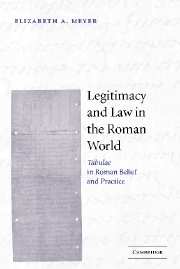Part Two - THE EVOLUTION OF PRACTICE
Published online by Cambridge University Press: 22 September 2009
Summary
The Roman ceremonial acts described in Part I, those unitary acts legal and otherwise that with the help of tablets reshaped and fixed human veritas, were deeply rooted in a wider world of belief, their efficacy an entrenched part of Roman tradition. Yet the world around ceremony changed in the late Republic and empire: as Rome's dominion, so too the number of Roman citizens increased. In their actions and observations these new citizens both asserted the traditionalism of ceremony and changed it, relied upon it and questioned it, maintained it and undermined it. Pressures of time and space had already caused some delicate queries about the efficacy of traditional ceremony, as Cicero's investigation of the census in the first century BC had shown. But conservative adjustments, like those of language (concepta verba for certa), kept these ceremonial acts usable, while praetorian endorsements of informal legal acts (like consensual rather than stipulatory contracts) kept these formal acts distinct, and juristic commentary preserved both useability and distinctiveness. Such adjustment and parallel development allowed Rome's expansion into world empire to stretch or multiply many traditional Roman institutions, and permitted Romans of the late Republic and empire to adapt and assert, rather than lose, some fundamental sense of what it meant to be Roman in a rapidly changing world.
- Type
- Chapter
- Information
- Legitimacy and Law in the Roman WorldTabulae in Roman Belief and Practice, pp. 121 - 124Publisher: Cambridge University PressPrint publication year: 2004

